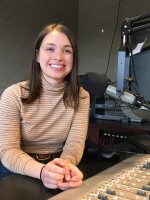Traffic congestion is among the top complaints for Park City residents and commuters; and reducing it is one of the top priorities for the city’s 10-year transportation plan. One way to do that is through the transit system—providing people leave the car at home and ride the bus.
Old Town resident Peter Marth says he hopes Park City someday becomes car-free. He says people won’t head to the transit hubs until traffic causes them to miss five or six powder days in a row.
"But until then, it's not going to happen," Marth said. "This town will become gridlock, and we're behind the curve with this car culture."
Park City Transportation Planning Manager Alfred Knotts says the decision to hop on the bus versus driving is almost always related to convenience.
“People will choose the automobile every time over taking transit, so we have to make sure that that service is attractive," Knotts said.
The Park City transportation team has tried to make riding the bus more appealing. The biggest barrier—fare—is a non-issue; Park City’s bus system is free to ride, which makes it accessible to everyone, regardless of income. The buses also feature other amenities, such as wi-fi and charging stations in the seats.
And their efforts are not all for naught. Ridership data from March 2019 show a 19% rise in passengers compared to March 2018, though a few things may have contributed to the increase. The data collection method has changed from bus drivers tallying heads to an automated system, possibly resulting in a more accurate count. Additionally, some routes have been adjusted, potentially catching more people in their service areas than before. But Mobility Data Analyst Robbie Smoot says the increase is large enough that he feels confident the system is gaining more individual riders altogether.
Still, some barriers prevent people from getting on the bus. Highland Estates resident Leslie Masters likes to bike, and she says when she and her friends want to go for a ride, they end up taking two cars to do it.
"They limit six bikes to a bus, so that means we drive up the hill to drop our car off, do our bike ride and drive back up to get our car, instead of taking the bus," Masters said.
Knotts says the purple route has been retrofitted to accommodate more bikes, since people like to ride down the Mid Mountain Trail from Empire Pass. But generally, the transportation department has found the front bumper-mounted bike racks have met the demand, and drivers can decide whether to allow bikes on the bus. The transportation team is also considering installing bike lockers at transit stops, to help ease first and last mile travel.
Another frequent complaint is that dogs aren’t allowed on buses. Knotts says it’s a potential liability to the city—plus, some passengers might be allergic—but also, they’ve been trying to develop a policy for it. Come October, though, dog owners could see a trial program that’s friendly to pups.
"One of those pilot periods that we hear about is Halloween, for the dog parade—again, to remove that barrier, because we do promote the bus very heavily during those events, especially Halloween," Knotts said. "If people want to be able to come down and bring their dog, that is an impediment to that."
And, of course, there’s commute time. Eugene McCarthy lives at Kimball Junction and works at Deer Valley. He says it takes him more than twice as long to get to and from work by bus as it does by car.
"It's taking me upwards of over an hour to get home and 45 minutes to get to work, while it's an 18-minute commute by car," McCarthy said. "I got keys, and I prefer to ride a bus—I’m trying to do what's responsible."
Knotts says yes, it does take longer to ride the bus than driving from door to door, and that’s due in part to the way Park City has been developed. But Knotts says it also requires a shift in mindset, where time on the bus can be used for something that can’t be done while driving.
"The relative travel time sometimes isn't as big as you would think it would be, and that’s some of those barriers we try to remove," Knotts said. "People just experiencing the bus and how they can better utilize their time, and just quality of life and experience—where you're not driving, and you might be able to do something else."
Associate Transportation Planner Alexis Verson says the transportation department hosts programs—like Try Transit Week—to encourage people to ride the bus and inform them about how local transit works. Additionally, the department will soon launch more surveys—both for riders and non-riders—to receive data to guide future planning efforts.


